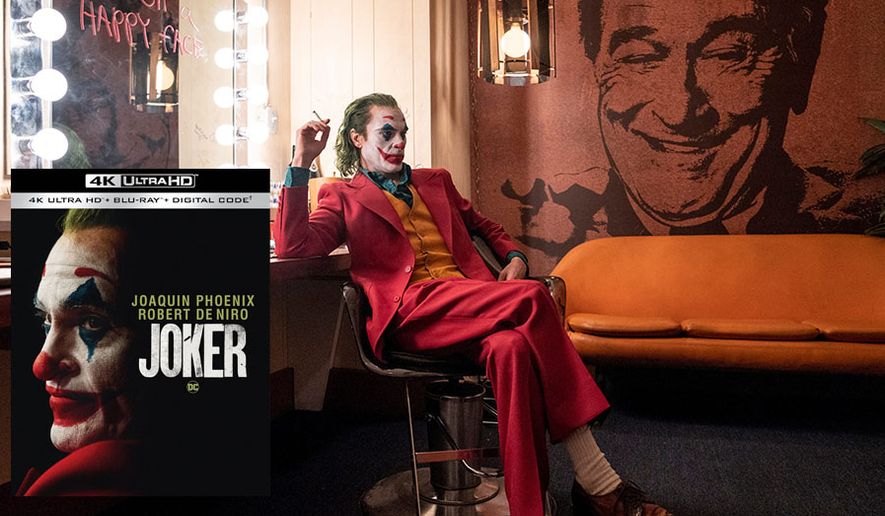Actor Joaquin Phoenix’s transformation into a familiar, clown-faced madman moves from its blockbusting theatrical run to ultra-high definition home theater screens in Joker (Warner Bros. Home Entertainment, Rated R, 1.85:1 aspect ratio, 122 minutes, $49.99).
Set in a Gotham City besieged by super rats, crime and chaos, the psychological thriller directed by Todd Phillips may only play out in the fringes of the Batman universe but packs a potent punch due to Mr. Phoenix’s riveting performance.
Viewers enter the world of Arthur Fleck, an adult man living with his mother, taking seven different medications to control various psychological issues and handicapped by a neurological condition that cause him to spontaneously burst into laughter when he is at his most stressed.
Losing his job as a clown, losing his social worker, constantly bullied and undermedicated and scorned by his favorite talk show host Murray Franklin (Robert De Niro), Arthur begins a decent into violent insanity that appeals to the city’s disenfranchised and ultimately turns him into a willing icon.
Whether he becomes the eventual archenemy of Batman is unclear, or even if he is the Clown Prince of Crime, but Mr. Phillips reminds us that we are clearly in the Dark Knight’s playground.
Viewers get to watch an unsympathetic Thomas Wayne and his potential run for mayor, a brief encounter by Mr. Fleck with a young Bruce Wayne and butler Alfred Pennyworth outside of Wayne Manor and the ultimate event that triggered the creation of the Batman.
Comparisons to previous Jokers are worth noting.
Heath Ledger provided evil for the sake of chaotic evil in “The Dark Knight” and Jack Nicholson offered a crime boss crazed by his own tragedy and narcissism in “Batman.”
Both performances were top notch but also mired by sharing screen time with the DC Comics’ hero.
Mr. Phoenix portrays a tragic figure plagued by mental illness that demands an audience’s sympathy amid his violent rampages.
However, the actor benefits by a film completely devoted to his performance, no Bats to share screen time with, and more than two hours to craft, by far, the most chilling origin story of Joker ever brought to the screen.
The film could easily have nothing to do with any comic book universe and fit nicely into Martin Scorsese’s gritty world of “Taxi Driver.”
As much as fans are clamoring for a meeting between this Joker and the Dark Knight in future films, I am not sure any actor playing Batman would have a chance against Mr. Phoenix’s level of pathos and unabashed unpredictability.
4K in action: Cinematographer Lawrence Sher creates a smothering and late 1970s version of a decaying Gotham presented with a sickly pall of blue, green and yellow tints in the full-screen presentation that sets a somber tone in many of the scenes.
When the veil gets occasionally lifted, the 2160p clarity shines, highlighted by a tear early on flowing down Arthur’s face with blue clown make-up while saturated color reigns supreme on the set of Murray Franklin’s talk show.
Viewers also get a study of Mr. Phoenix’s face down to every laugh line enhanced by the poorly applied clown make-up and especially chilling when watching blood stains caked on his pasty white face.
Although the film’s transfer comes from the 4K master, it the subject material does does not require the upgrade but rather would even more visually arresting with less detail, the more grizzled and Grindhouse the better. I’d love to see this film in black and white.
Almost more important than the visuals is the Dolby Atmos soundtrack that really brings to life the enveloping and haunting musical score from Hildur Guðnadóttir that features “impending doom” cello passages eliciting dread during Arthur’s sobering existence.
Best extras: Considering the pop culture roots and mega-popularity of the film, I am thoroughly disappointed with the smattering of bonus content found only on the Blu-ray disc.
Viewers get a 90-second study of the many faces of Mr. Phoenix’s Joker; 3 minutes of variations of the Joker’s appearance on the “Live with Murray Franklin” show; and a 3-minute Ken Burns-style slideshow of the entire “Joker” film.
Best of the slim pickings is a 22-minute overview of the production covering the movie’s origins, the spontaneity of the acting, its design and score, and featured interviews from Mr. Phillips, producer Bradley Cooper, Mr. Phoenix and production designer Mark Friedberg.
Considering the complexity of the movie, an optional commentary track by the director would have been welcomed.
Hold on there cinemaphiles, use the digital streaming code in the package and that coveted optional commentary track with Mr. Phillips exists exclusive to the iTunes format.
The man is a fount of information as he offers a nonstop dive in the film’s details and really covers motivations, themes, the meticulous work of Mr. Phoenix, shooting in real locations in New York City and even finding the perfect stairs for Arthur to have to conquer very time he goes home.
Mr. Phillips reminds listeners to key into the “everything must go” sign twirled by Joker that really sets the tone for a movie asking viewers to get rid of any preconceived notions about heroes and villains.
• Joseph Szadkowski can be reached at jszadkowski@washingtontimes.com.




Please read our comment policy before commenting.